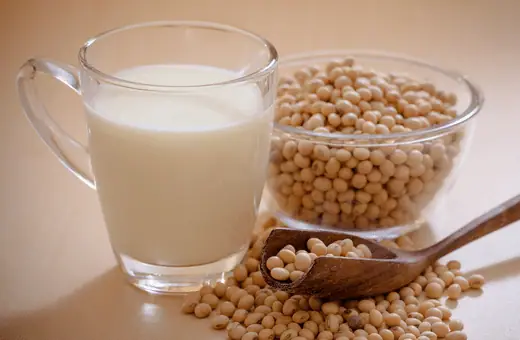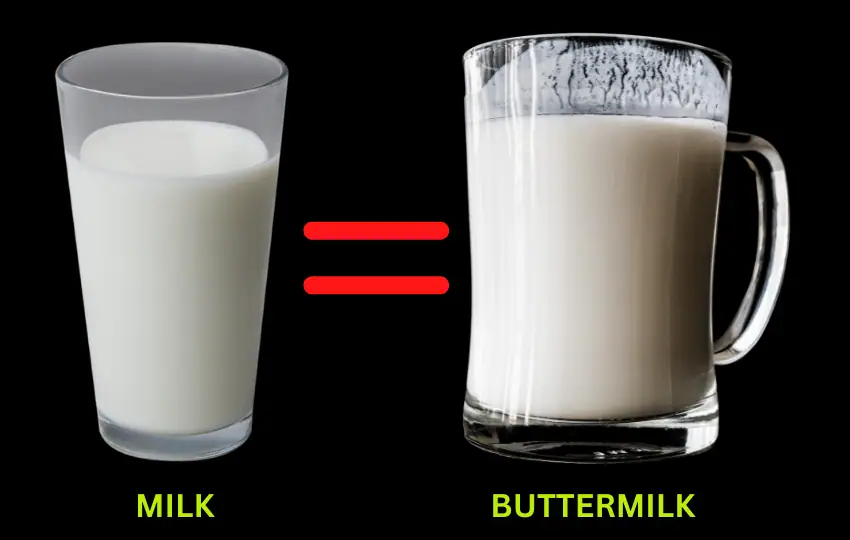Buttermilk is a key ingredient in many recipes, from pancakes to cakes. It adds flavor and moisture to the dish while also acting as a leavening agent.
But what if you don’t have any on hand?
Is it possible to substitute regular milk for buttermilk in a recipe? Let’s explore the answer.
can you substitute milk for buttermilk?
The answer is yes; you can substitute regular milk for buttermilk in most recipes. But keep in mind that the consistency and flavor of your dish won’t be quite the same as if you had used buttermilk.
In order to get the closest result to using real buttermilk, combine one cup of regular milk with one tablespoon of white vinegar or lemon juice and let it sit for five minutes until it thickens.
The acidity will cause the milk to curdle and thicken to a similar consistency as real buttermilk.
Another option is substituting yogurt, either plain or Greek yogurt, for buttermilk. Yogurt has a slightly tangy flavor that mimics the tanginess of buttermilk.
However, if you use this substitution, use an equal amount of yogurt as called for in the recipe and mix it with water until it reaches the same consistency as the original recipe calls for (usually 1 cup).
You can also substitute sour cream for buttermilk in some recipes—just remember to reduce other ingredients, such as oil or butter, by about 25% when doing so.
What happens if you substitute milk for buttermilk?
Substituting milk for buttermilk in baking or cooking can affect the results of a recipe significantly.
Milk is mostly composed of water and carries a mild flavor, while buttermilk contains beneficial bacteria cultures to give it its characteristic sharp taste.
Milk does not contain the additional acidity that buttermilk does, which is why it is often used in baked goods – to tenderize the mixture and make it airier.
As a result, recipes that rely exclusively on buttermilk tend to be heavier and less light if you use milk instead.
But using milk doesn’t always have to mean missing out – consider pancakes, where many find that altering the usual proportions of flour and milk creates a thinner and more delicate batter than when using buttermilk.
Ultimately, if you’re considering substituting milk for buttermilk, it’s worth assessing your recipe on a case-by-case basis to determine whether it will work out as desired.
How much milk do I substitute for buttermilk?
For a perfect substitute for buttermilk, you’ll need some milk or other dairy product. The amount of milk you use will depend on the recipe.
Generally speaking, if the recipe calls for 1 cup of buttermilk, you can replace that with 1 cup of regular milk plus 1 tablespoon of lemon juice or vinegar.
You will likely want to let your milk and acid sit for up to 10 minutes, if possible, before using it to ensure it thickens properly.
The resulting mixture should be better known as ‘soured milk’ and is an excellent alternative for scarce buttermilk!
However, if the recipe does not call for an acid ingredient, such as baking soda, then sour cream can be a good substitute as it is thicker than milk and will make baked goods moister due to its fat content.
Best Substitute for Buttermilk
1. Substitute Milk and Lemon Juice or Vinegar
One of the most common ways to mimic buttermilk is with regular milk and either lemon juice or vinegar.
To make this substitution, you can combine one cup of milk with 1 tablespoon of either lemon juice or white vinegar and let it sit for about 5 minutes until it thickens slightly.
This combination will not be as acidic as real buttermilk, so if your recipe calls for that tartness, you may want to consider another option.
2. Sour Cream
Sour cream is used in place of buttermilk in some recipes, particularly those that do not require large quantities of buttermilk (such as pancakes).
Simply you can replace 1 cup of buttermilk with ¾ cup sour cream plus 1/4 cup water and mix together until fully combined.
Sour cream will give your recipe a richer flavor than other substitutes since it contains more fat than traditional buttermilk.

For a slightly thicker substitute than yogurt, try mixing together ½ cup of sour cream plus ½ cup of regular milk or water for every 1 cup of buttermilk demanded in your recipe.
The sour cream will add richness and tanginess to whatever dish you’re making while still giving you that creamy texture like real buttermilk does.
3. Yogurt
Yogurt is another popular substitute for buttermilk because it has a similar texture and acidity level as traditional buttermilk, making it perfect for baking applications like muffins or quick bread where you want the dough to rise properly.
You can use yogurt as an alternative to buttermilk. Simply replace 1 cup of buttermilk with ¾ cup of plain yogurt plus ¼ cup of regular milk (or water).
Make sure to use plain yogurt – flavored versions will add too much sweetness to your recipe!
4. Coconut Milk/Cream
If you’re vegan or dairy-free, coconut milk makes an excellent substitute for traditional buttermilk in many recipes, such as pancakes and muffins.
Just combine 1 cup of coconut milk with 1 teaspoon of white vinegar or lemon juice and let it sit at room temperature until thickened (about 15 minutes).
The coconut milk will add a subtle sweetness while still providing that rich, creamy texture we all love about real buttermilk!
5. Almond Milk
For another vegan-friendly option, combine 1 cup of almond milk with 1 tablespoon of lemon juice or white vinegar and let it sit at room temperature until thickened (about 15 minutes).
This combination will also give you that thick texture without any dairy products!
6. Cashew Milk
Just like almond milk, cashew milk can also be used as a substitute for traditional buttermilk in baking recipes such as cakes and muffins!
Again, you can mix together 1 cup of cashew milk with 1 tablespoon of lemon juice or white vinegar and let it sit at room temperature until thickened (about 15 minutes).
The cashew milk will provide a subtle nutty flavor while still giving your dishes that rich thickness we all know and love from real buttermilk!
7. Soy Milk
Last but not least is soy milk! To use soy milk instead of traditional cow’s milk buttery goodness.
Simply mix together 1 cup of soy milk with 2 tablespoons each of white vinegar or lemon juice, then let it sit at room temperature until thickened (about 15 minutes).

Soy milk has more protein than other non-dairy milk, so this substitution would be perfect if you’re looking to add more protein to your baking recipes!
8. Milk and Cream of Tartar
For those who don’t want to use vinegar as an ingredient, another option is to mix one tablespoon of cream of tartar per cup of whole milk instead.
The acidic properties found in cream of tartar help mimic the tanginess found in real buttermilk, making this combination a great choice when baking cakes or muffins that need something extra special added to them.
Can I make my own buttermilk?
Making your own buttermilk is an easy, cost-effective way to prepare many recipes. It also requires minimal ingredients!
Simply mix half a teaspoon of white vinegar or lemon juice with a cup of whole or 2% milk. Allow the mixture to stand for about 5 minutes, and briefly stir before use.
Homemade buttermilk has a shorter shelf life than store-bought, so it’s best to use it right away or store it in the refrigerator for up to three days.
Be sure to give your homemade buttermilk a good shake or stir each time before use, just as you would do with store-bought buttermilk!
Is there a big difference between milk and buttermilk?
Milk and buttermilk both come from cows, but that’s pretty much where the similarities end.
Compared to normal milk, buttermilk has a thicker texture, usually with a slightly sour or tangy taste due to the presence of lactic acid bacteria.
Regular milk contains around 4% fat, while buttermilk contains only 1%, making it a widely preferred choice for health-conscious consumers.
Additionally, due to its lower fat content and fermentation process, dairy scientists have found that buttermilk lasts longer than regular milk.
Furthermore, buttermilk also contains special enzymes, which give it great properties for use in baking – and this means you’ll often find this type of milk used as an ingredient in many baked goods and desserts.
Ultimately though, it’s up to individual taste as to which dairy product you prefer when cooking or making other recipes!
FAQs on substitute milk for buttermilk
Q1. What can you use if you don’t have buttermilk?
Buttermilk is an ingredient that gives baked goods a unique texture and flavor, but it certainly isn’t necessary to have on hand for successful baking.
Rather than running to the store for a carton of buttermilk, you can make a reliable substitute at home by combining milk and lemon juice or vinegar.
Simply combine one cup of milk with one tablespoon of either lemon juice or vinegar, then set aside for 5 minutes until it thickens – this combination acts in a similar way as the real thing!
You can even try using alternative milk like almond milk or coconut milk; just remember that each type may yield slightly different results.
If you happen to have any yogurt on hand, you could use plain yogurt as well – about 1/2 cup of plain yogurt replaces one cup of buttermilk in most recipes.
So don’t let not having buttermilk prevent you from pursuing your culinary desires; there are plenty of great alternatives!

